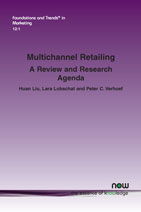Multichannel Retailing: A Review and Research Agenda
By Huan Liu, University of Groningen, The Netherlands and University of Chinese Academy of Sciences, China, huan.liu@rug.nl | Lara Lobschat, University of Groningen, The Netherlands, l.lobschat@rug.nl | Peter C. Verhoef, University of Groningen, The Netherlands, p.c.verhoef@rug.nl
Abstract
The emergence of multiple channels is reshaping consumers’ purchase behavior and retailers’ marketing styles. We synthesize existing research on multichannel retailing based on more than 150 articles published in peer-reviewed marketing journals, most after 2006. From this synthesis, we reveal conditions under which both consumers and retailers can benefit from a multichannel context. More specifically, we identify multichannel retailing as a win-win game contingent on market environments, retailer characteristics, channel attributes, product categories, social and situational factors, and customer heterogeneity. Last, we highlight multiple directions for future research
Multichannel Retailing: A Review and Research Agenda
Multichannel Retailing: A Review and Research Agenda presents an overview of and draws conclusions from extant studies related to multichannel retailing. Academic interest in this topic has increased dramatically, with a large number of new articles being published on this topic as retailers have adopted additional new channels and new channel technologies with unique characteristics, which has further increased the complexity of multichannel retailing. Thus, an updated understanding of how retailers and consumers influence and interact with each other in multichannel retail contexts is required. The authors focus on the following questions: (1) What factors influence channel choices of retailers and customers? (2) How do retailers employ multichannel marketing strategies, and how do customers use different channels to search and purchase during their purchase journey? And (3) How do multichannel strategies and channel selection behavior affect customer outcomes and retailer performance? After presenting the definitions of key terms used in multichannel retailing, the authors introduce their framework. Next, they synthesize existing research and specify the three research questions with six subtopics by considering the perspectives of both customers and retailers. At the end of each subtopic, the authors discuss future research directions derived from research gaps, unresolved issues in practice, and environment changes. The monograph concludes with thoughts about the future of retailing.
